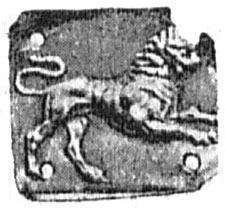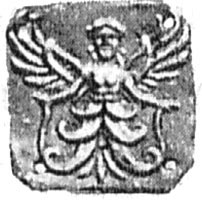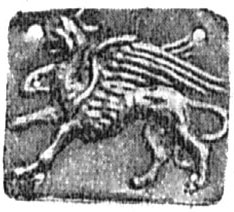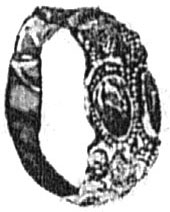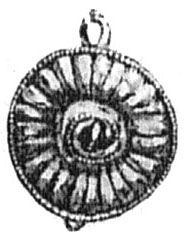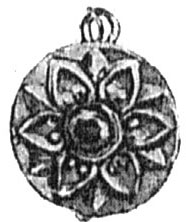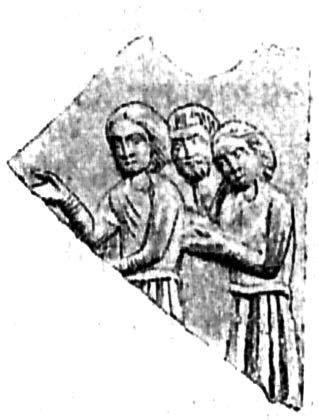 |
 |
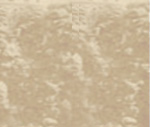 |
|
||
| main :: biography :: texts :: manuscripts :: photographs :: drawings :: squeezes :: publications :: about | ||
|
Year 1893 ...
TAURIDA GOVERNMENT (GUBERNIA).
The Archaeological Commission ordered 1893 excavations in the city site of Chersonesos to be organized at places that were most menaced by the possibility of damage or devastation, and namely: near the warehouse of antiquities, near the so-called Uvarov basilica, around the monastery cemetery, in the s<outh>-w<est> extremity of the ancient city, and in the necropolis. In order to protect the northern wall of the building that was aimed to be the warehouse of antiquities and to connect the watchhouse with the old blindage (it was arranged for the storage of tools), we had to remove soil mound as long as about 12 sazh<enes>, so that the finds include: different small artifacts, splinter of marble pedestal with fragmented inscription dedicated to Bosporan king Aspurgus (second century AD) and fragment of slab with remnants of some Latin inscription. In the same place, there was drainage well, carved into bedrock as deep as 7 arch<ines>, so it reached the sea water, and was later blocked with soil and stones and covered with a wall of some upper city building above. To the left of Uvarov basilica, supplementary investigations were made to unearth the minor basilica in full (it had been discovered in 1877). It appeared that this basilica had 6 pillars used as foundations for columns. Relatively big number of finds collected in course of the above excavations dates to the Greco-Latin and Byzantine periods of the history of Chersonesos and does not give any new type. The excavations along the seashore, near the monasterial graveyard, became necessary because the monastery declared its intention to encircle the graveyard with stone wall. The excavations were also aimed to connect the trenches made in different areas in the sea coast in 1889, 1891, and 1892. The results of the works n this area are interesting because they discovered basilica, two altarless churches and a large building. On the floor of the basilica, there were 2 fragments of marble cornice, and in the chancel was interesting stone box with pull-out side wall; besides that, the basilica contained a number of different marble fragments, including 6 slabs with Greek inscriptions, part of column made of pinkish marble from Balaklava, fragment with image of cross, carved in the middle of relief circle, which appears for the first time, etc. In the basilica and the altarless church most close to it, there were 14 tombs containing, apart from a great number of bones, many glass bracelets, as well as finger-rings, buckles, buttons, and thimble. The big building is interesting because of its terrace, having traces of marble facing, and basement floor that contained round oven. The second room from the w<est> contained 192 copper coins of Chersonesos minted in the age of the emperor Romanus I. Near this building, there were two pear-shaped cisterns, carved into bedrock, one more than 3 archines deep and the other 5 arch<ines> deep. Behind the cisterns, site of an altarless church was uncovered. In this area of the ancient city, cultural layer is as deep as 2 sazh<enes>. The excavations unearthed a number of artifacts of the ancient, as well as of the modern period, such as black-slip lamps, bronze ram's head, heavily worn-off fragment of stone axe, 2 copper dagger-shaped pendants, fragment of bronze icon lamp chain, vessels of embossed copper sheets, coins from different periods, etc. New interesting and important discoveries have been made when building new artillery batteries in the s<outh>-w<estern> extremity of the ancient city site; and namely, the corner of the city wall was unearthed within the distance of 65 sazh<enes> and the site of water pipe was uncovered. It turned out that Chersonesan wall was faced with dressed slabs of different length, carefully adjusted to each other. In course of the wall, 2 projections were observed, in the form of quadrangular towers, and the corner of the wall was occupied by round flanking tower with narrow passageway and sally port; on the outside, the tower is protected by a special, also round, wall in the form of a counterscarp. Behind the first wall and a certain distance far from it, we uncovered the remains of the second wall, also faced with stones. There were two water pipes. They entered the city to the w<est> from the place where the wall turned. The first aqueduct was quadrangular in cross-section and went in between of the walls, and the second one was oval in section and went along the second wall. Both aqueducts were covered with stones from above. According A. L. Berthier de Lagarde, there should be ancient gate in this section of the wall, as traces of roads leading to this place are still visible now, and the site of the building with massive walls discovered nearby could be interpreted as traces of a small citadel placed there to protect the gate. The finds uncovered in the works arranged by the Military Department were not important and included mainly marble fragments, earthenware pottery, and coins. However, it is very important for the topography of Chersonesos that several ancient Greek graves were uncovered on either side of the wall; this fact proves the early hypothesis that the Roman wall was erected above a part of the ancient necropolis, which was exactly in this place and nowhere else.
Among the great number of finds uncovered by 1893 excavations in the city site of Chersonesos, the following ones belong to the types that were never met before or were extremely rare: fine wedding ring of gold, decorated with smallest granulation and 2 garnets that fell out of the sockets
(fig. 4)
, gold earrings with round plates at the face side
(fig. 5 and fig. 6)
, copper badge with possible image of Europa (s<ee> fig. 38), silver brooch
(s<ee> fig. 41)
, elongated copper heart-shaped badge, encrusted with garnets, some of them were missing
(fig. 43)
, two fragments of images carved into slate tablets (on the one, there is image of the Savior, sitting, on the other of three persons in the praying pose
(fig. 8)
; terracotta lamp with image of Amur and another one portraying a dog
(fig. 7 and
fig. 45), fragment of some clay artifact with several imaged that probably are not connected to each other
(fig. 33)
, terracotta statuette of horse with bent legs
(fig. 46)
, two types of big bronze cuff links
(fig. 42)
, original bronze pole top with cross in semicircles
(fig. 44)
, copper horse bits
(s<ee> fig. 40)
, and others.
From 1893 Report of the Imperial Archaeological Commission, signed by the Chair count A. A. Bobrinskiy. Published in Saint Petersburg, 1895.
|
| ©National Preserve of Tauric Chersonesos . 2007 - 2026 |
